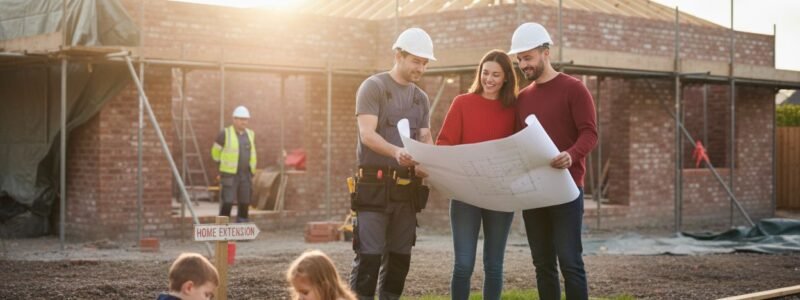Home extensions sound simple until you see what really drives up the price. A modest single-storey kitchen extension can cost between £30,000 and £50,000 yet a two-storey side extension easily hits £80,000 or more. Most people think it is just the bricks and timber that matter. But it is the planning fees, hidden regulatory loopholes, and location quirks that decide if your dream space becomes a financial headache or a valuable investment.
Table of Contents
- Defining Extension Costs: What Are They?
- Key Factors Influencing Extension Costs
- Why Understanding Extension Costs Matters
- Real-World Examples Of Extension Cost Variations
- Navigating The Extension Cost Landscape In London
Quick Summary
| Takeaway | Explanation |
|---|---|
| Extension costs extend beyond construction expenses | Home extension costs include design, materials, and labour, requiring thorough financial planning. |
| Location significantly impacts project costs | Urban locations incur higher expenses due to labour rates, regulations, and material transport. |
| Material quality affects long-term value | Choosing high-quality materials provides durability and increases property value, balancing initial costs with future returns. |
| Size and complexity lead to pricing variations | Larger extensions exponentially increase costs; even minor design choices can have considerable financial implications. |
| Regulatory compliance can escalate overall expenses | In areas like London, strict regulations and planning permissions add layers of cost that must be navigated carefully. |
Defining Extension Costs: What Are They?
Home extension costs represent a comprehensive financial investment involving multiple components beyond basic construction expenses. These costs encompass the total financial commitment required to transform and expand your living space successfully. Architectural research from the Royal Institute of British Architects highlights that extension pricing is multifaceted and requires careful consideration of various interconnected elements.
Core Components of Extension Costs
Extension costs are not simply about building walls and adding square metres. They involve a complex combination of direct and indirect expenses that homeowners must understand. The primary cost categories include:
- Design and Planning Fees: Professional architectural and planning permission expenses
- Construction Materials: Structural elements, insulation, windows, doors
- Labour Costs: Skilled tradespeople including builders, electricians, plumbers
The total investment goes far beyond surface-level construction. Every extension project involves intricate financial planning and strategic budgeting. Read more about understanding the detailed cost breakdown of extensions.
Factors Influencing Overall Expenditure
Multiple dynamic factors impact the total extension cost. Size remains a critical determinant, with larger extensions naturally requiring more materials and labour. Location plays a significant role too, as construction costs in urban areas like London tend to be substantially higher compared to rural regions. Material quality, design complexity, and specific structural requirements can dramatically alter the final price point.
Understanding these nuanced cost elements allows homeowners to develop realistic budget expectations and make informed decisions about their home improvement projects. By breaking down the comprehensive financial landscape, property owners can strategically plan their extension investment.
The following table clearly summarises the core components that contribute to overall home extension costs, helping readers to understand each element and its typical scope.
| Component | Description |
|---|---|
| Design and Planning Fees | Professional architectural and planning permission expenses |
| Construction Materials | Includes structural elements, insulation, windows, and doors |
| Labour Costs | Skilled tradespeople, such as builders, electricians, plumbers |
| Regulatory Compliance | Fees for meeting local authority and building regulations |
| Site Preparation | Work required to prepare the site for construction |
| Contingency Allowance | Extra funds for unforeseen expenses or changes |
Key Factors Influencing Extension Costs
Understanding the intricacies of extension costs requires a comprehensive analysis of multiple interconnected variables that significantly impact overall project expenses. Research from the Construction Industry Council reveals that successful home extension planning demands meticulous evaluation of several critical factors.
Material Selection and Quality
The choice of materials represents a fundamental cost determinant in any extension project. High-quality materials naturally command premium prices but offer superior durability and aesthetic appeal. Homeowners must balance budget constraints with long-term performance considerations. Material selections impact not just immediate construction expenses but also future maintenance requirements.
Key material cost considerations include:
- Structural Materials: Brickwork, concrete, steel frameworks
- Finishing Materials: Flooring, wall treatments, roofing elements
- Insulation and Energy Efficiency: Advanced materials that potentially reduce long-term energy expenses
Explore our comprehensive guide on home extension cost factors to gain deeper insights into material selection strategies.
Geographical and Structural Complexity
Location and structural complexity play pivotal roles in determining extension costs. Urban environments like London present unique challenges with higher labour rates, stricter building regulations, and potentially complex site conditions. Structural intricacies such as foundation requirements, existing building modifications, and specific architectural design elements can substantially escalate project expenses.
Professional assessments are crucial in understanding potential complexities that might impact overall project budgeting.
Factors like soil composition, proximity to neighbouring structures, and local planning restrictions can introduce unexpected financial considerations that significantly influence total investment requirements.
Why Understanding Extension Costs Matters
Comprehensive knowledge of extension costs goes far beyond mere financial planning it represents a strategic approach to property enhancement and long-term investment management. Financial analysis from the UK Property Investment Research Centre demonstrates that informed homeowners make significantly more financially sound decisions regarding home improvements.
Financial Planning and Risk Management
Understanding extension costs enables homeowners to develop robust financial strategies that protect against unexpected expenses and potential project overruns. Thorough cost comprehension allows for:
- Accurate Budgeting: Creating realistic financial frameworks
- Risk Mitigation: Identifying potential financial challenges early
- Investment Protection: Ensuring improvements align with property value
Careful financial planning transforms extension projects from potential financial risks into calculated, strategic investments. Learn about the cost and value of home extensions to make more informed decisions.
Property Value and Long-Term Considerations
Extension costs are not just about immediate expenses but represent a critical investment in property valuation. Professional assessments reveal that well-planned extensions can substantially increase property market value, potentially offering returns significantly exceeding initial investment costs. Homeowners who thoroughly understand cost dynamics can strategically design extensions that balance aesthetic improvements with financial pragmatism.
Beyond immediate construction expenses, intelligent extension planning considers long-term factors such as energy efficiency, maintenance requirements, and potential future resale value. By approaching extension costs as a comprehensive investment strategy, property owners transform home improvements from mere structural changes into valuable financial assets.
Real-World Examples of Extension Cost Variations
Home extension projects demonstrate remarkable diversity in pricing, with actual costs reflecting a complex interplay of multiple variables. Construction industry research from the National House Building Council reveals significant variations in project expenses based on unique contextual factors.
Urban vs Rural Extension Scenarios
Geographical location dramatically influences extension pricing, creating substantial cost disparities. London-based extensions typically incur higher expenses compared to rural property improvements. Urban extension projects often encounter additional challenges:
- Labour Rates: Significantly higher metropolitan workforce costs
- Material Transportation: Increased logistical expenses
- Regulatory Compliance: More complex planning permission processes
Explore our comprehensive guide on home extension cost factors to understand regional pricing nuances.
Extension Size and Complexity Comparisons
Extension costs demonstrate exponential complexity when project scale increases. A modest single-storey kitchen extension might range between £30,000 to £50,000, whereas a sophisticated two-storey side extension could escalate to £80,000 or beyond.
 Factors like architectural design intricacy, structural modifications, and specific functional requirements create substantial pricing variations.
Factors like architectural design intricacy, structural modifications, and specific functional requirements create substantial pricing variations.
Professional assessments highlight that seemingly minor design choices can trigger significant financial implications. Homeowners must approach extension planning with meticulous attention to detail, recognising that each design decision carries potential economic consequences.
This table compares how extension costs can differ significantly depending on both location (urban vs rural) and the size and complexity of the project, as discussed in the article.
| Scenario | Typical Cost Range | Key Cost Factors Highlighted |
|---|---|---|
| Single-storey kitchen extension (rural) | £30,000–£50,000 | Basic construction, fewer regulatory and logistical challenges |
| Two-storey side extension (urban) | £80,000+ | Higher labour rates, planning permissions, increased complexity |
| Urban extension (e.g., London) | Higher overall | Labour, material transport, complex regulations |
| Rural extension | Lower overall | Lower labour costs, simpler logistics, less regulatory oversight |

Navigating the Extension Cost Landscape in London
London presents a unique and complex environment for home extensions, characterized by distinctive architectural challenges and stringent regulatory frameworks. Urban development research from the London School of Economics underscores the intricate financial considerations specific to metropolitan property improvements.
Regulatory and Planning Complexities
The London extension landscape demands exceptional navigational skills from homeowners. Statutory requirements significantly influence project costs, with multiple layers of bureaucratic oversight creating additional financial considerations. Local borough regulations often impose strict guidelines that can substantially impact overall project expenses:
- Conservation Area Restrictions: Specific design limitations
- Listed Building Constraints: Enhanced compliance costs
- Permitted Development Rights: Complex approval processes
Explore our comprehensive home extension cost calculation guide to understand these intricate financial dynamics.
Property Typology and Cost Implications
London’s diverse housing stock presents unique extension challenges. Terraced houses, prevalent in areas like Islington and Hackney, require specialized architectural approaches that can dramatically alter cost structures. Victorian and Edwardian properties often necessitate complex structural modifications, introducing additional engineering and design expenses.
Homeowners must recognize that each property represents a distinct financial ecosystem. Factors such as existing structural integrity, soil conditions, and neighbourhood architectural characteristics create nuanced cost variations that demand sophisticated, tailored planning strategies.
Take Control of Your Extension Costs Today
Feeling overwhelmed by the unpredictable nature of extension costs? We understand that planning a home extension in London or Surrey can be complicated. From managing material choices to navigating planning permissions, every decision impacts your budget and adds uncertainty. Achieving your dream space without hidden surprises or escalating expenses is possible, but only with the right knowledge and professional support. For clear advice on what really affects your extension costs and how to protect your investment, explore our Cost & Value of Home Extensions resource for more real-life examples and practical guidance tailored to your needs.
Ready to stop guessing and gain transparency in your project costs? Speak directly to our expert team with over 20 years’ experience and receive a personalised breakdown for your unique project. Contact us now using our quick enquiry form for a no-obligation consultation. Secure your extension project with the guidance, pricing clarity, and peace of mind you deserve—from design to completion.
Frequently Asked Questions
What are the main factors that impact extension costs for my home?
The core factors that impact extension costs include design and planning fees, construction materials, and labour costs. To get a clearer understanding, calculate potential expenses by estimating your project’s size and complexity based on these components.
How can I effectively budget for my home extension?
Create a comprehensive budget by assessing direct costs like materials and labour, as well as indirect costs such as permits and potential design changes. Break down your budget into categories and review it regularly to ensure it stays on track, aiming to allocate a contingency budget of about 10-15% for unexpected expenses.
How does the location of my home affect extension costs?
The location significantly influences extension costs since urban areas often experience higher labour rates and material transportation costs. Evaluate your specific site conditions and local regulations to create a realistic estimate for your extension project.
What should I consider when selecting materials for my extension?
Focus on the balance between cost and quality when selecting materials for your extension. Prioritise high-quality options that provide durability while factoring in long-term maintenance to reduce potential costs in the future.
How do design complexity and structural requirements affect overall extension costs?
More complex designs and specific structural requirements can escalate extension costs substantially. To manage these costs, consult with professionals to assess your design choices early in the planning stage and adjust them as needed to fit your budget.
What role do planning permissions and regulations play in extension costs?
Planning permissions and local regulations can introduce additional costs due to compliance requirements and potential delays. Familiarise yourself with your local regulations early to incorporate these considerations into your budget and timeline effectively.





